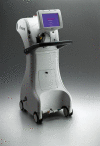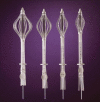Accelerated Partial Breast Irradiation (APBI): A review of available techniques
- PMID: 20920346
- PMCID: PMC2958971
- DOI: 10.1186/1748-717X-5-90
Accelerated Partial Breast Irradiation (APBI): A review of available techniques
Abstract
Breast conservation therapy (BCT) is the procedure of choice for the management of the early stage breast cancer. However, its utilization has not been maximized because of logistics issues associated with the protracted treatment involved with the radiation treatment. Accelerated Partial Breast Irradiation (APBI) is an approach that treats only the lumpectomy bed plus a 1-2 cm margin, rather than the whole breast. Hence because of the small volume of irradiation a higher dose can be delivered in a shorter period of time. There has been growing interest for APBI and various approaches have been developed under phase I-III clinical studies; these include multicatheter interstitial brachytherapy, balloon catheter brachytherapy, conformal external beam radiation therapy and intra-operative radiation therapy (IORT). Balloon-based brachytherapy approaches include Mammosite, Axxent electronic brachytherapy and Contura, Hybrid brachytherapy devices include SAVI and ClearPath. This paper reviews the different techniques, identifying the weaknesses and strength of each approach and proposes a direction for future research and development. It is evident that APBI will play a role in the management of a selected group of early breast cancer. However, the relative role of the different techniques is yet to be clearly identified.
Figures













References
-
- SEER Cancer Statistics Review, 1975-2006. http://seer.cancer.gov/csr/1975_2006/
-
- U.S. Cancer Statistics Working Group. United States Cancer Statistics: 1999-2006 Incidence and Mortality Web-based Report. Atlanta: U.S. Department of Health and Human Services, Centers for Disease Control and Prevention and National Cancer Institute; 2010. http://www.cdc.gov/uscs
-
- anon. Book Cancer Statistics registrations: Registrations of cancer diagnosed in 2006, England. (Editor ed.^eds.) City: National Statistics; 2009. Cancer Statistics registrations: Registrations of cancer diagnosed in 2006, England.
Publication types
MeSH terms
LinkOut - more resources
Full Text Sources
Other Literature Sources
Medical
Research Materials

